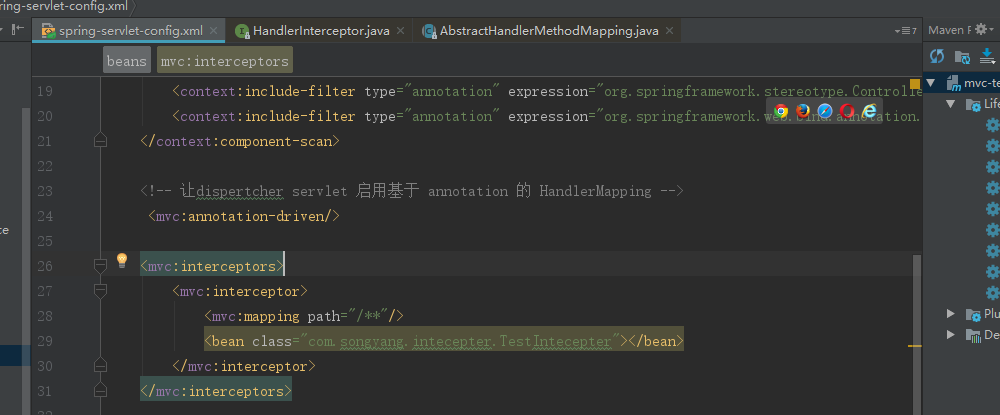前言
在前面分析getHandler时,我们发现返回的并不是简单的HandlerMethod而是HandlerExecutionChain,本篇就是完成对其中拦截器分析。
概述
在分析之前,我们先记住几个类名,HandlerInterceptor、HandlerInterceptorAdapter、MappedInterceptor。
- HandlerInterceptor是spring mvc的基础接口,它提供了三个抽象方法,分别在获取到handler之后、适配器调用了hander之后、渲染视图之后
- HandlerInterceptorAdapter是HandlerInterceptor接口的抽象类,我们在开发扩展时,一般不去实现HandlerInterceptor,而是去继承这个抽象类。
- MappedInterceptor是HandlerInterceptor的实现类,我们在配置文件中的拦截器都会被包装成这个类。
贴上配置

源码分析
上面添加了拦截器的配置,那么第一步肯定的配置的解析过程,我们找到相应的解析器进行去
- 解析<mvc:interceptors>的配置,注册bean定义信息到容器中,这个过程比较简单
- 遍历<mvc:interceptors>下所有的<mvc:interceptor>
- 创建MappedInterceptor的定义信息,并把路径映射信息、指定的拦截器bean给设置进去
- 向容器中注册MappedInterceptor的定义信息
//InterceptorsBeanDefinitionParser类的方法
//解析<mvc:interceptors>标签
public BeanDefinition parse(Element element, ParserContext parserContext) { CompositeComponentDefinition compDefinition = new CompositeComponentDefinition(element.getTagName(), parserContext.extractSource(element)); parserContext.pushContainingComponent(compDefinition); RuntimeBeanReference pathMatcherRef = null; if (element.hasAttribute("path-matcher")) { pathMatcherRef = new RuntimeBeanReference(element.getAttribute("path-matcher")); } List<Element> interceptors = DomUtils.getChildElementsByTagName(element, "bean", "ref", "interceptor"); for (Element interceptor : interceptors) { RootBeanDefinition mappedInterceptorDef = new RootBeanDefinition(MappedInterceptor.class); mappedInterceptorDef.setSource(parserContext.extractSource(interceptor)); mappedInterceptorDef.setRole(BeanDefinition.ROLE_INFRASTRUCTURE); ManagedList<String> includePatterns = null; ManagedList<String> excludePatterns = null; Object interceptorBean; if ("interceptor".equals(interceptor.getLocalName())) { includePatterns = getIncludePatterns(interceptor, "mapping"); excludePatterns = getIncludePatterns(interceptor, "exclude-mapping"); Element beanElem = DomUtils.getChildElementsByTagName(interceptor, "bean", "ref").get(0); interceptorBean = parserContext.getDelegate().parsePropertySubElement(beanElem, null); } else { interceptorBean = parserContext.getDelegate().parsePropertySubElement(interceptor, null); } mappedInterceptorDef.getConstructorArgumentValues().addIndexedArgumentValue(0, includePatterns); mappedInterceptorDef.getConstructorArgumentValues().addIndexedArgumentValue(1, excludePatterns); mappedInterceptorDef.getConstructorArgumentValues().addIndexedArgumentValue(2, interceptorBean); if (pathMatcherRef != null) { mappedInterceptorDef.getPropertyValues().add("pathMatcher", pathMatcherRef); } String beanName = parserContext.getReaderContext().registerWithGeneratedName(mappedInterceptorDef); parserContext.registerComponent(new BeanComponentDefinition(mappedInterceptorDef, beanName)); } parserContext.popAndRegisterContainingComponent(); return null; }
- 在分析找到Controller的那篇中,我们看到RequestMappingHandlerMapping是实现了ApplicationAware接口的,所有在实例化的时候要调用setApplicationContext接口的。而这个方法的实现类是在RequestMappingHandlerMapping的父类ApplicationObjectSupport中的。这个方法设置给RequestMappingHandlerMapping设置了application属性,并初始化上下文。
//ApplicationObjectSupport类的方法
//设置容器对象到当前对象中
public final void setApplicationContext(ApplicationContext context) throws BeansException { if (context == null && !isContextRequired()) { // Reset internal context state. this.applicationContext = null; this.messageSourceAccessor = null; } else if (this.applicationContext == null) { // Initialize with passed-in context. if (!requiredContextClass().isInstance(context)) { throw new ApplicationContextException( "Invalid application context: needs to be of type [" + requiredContextClass().getName() + "]"); } this.applicationContext = context; this.messageSourceAccessor = new MessageSourceAccessor(context); initApplicationContext(context); } else { // Ignore reinitialization if same context passed in. if (this.applicationContext != context) { throw new ApplicationContextException( "Cannot reinitialize with different application context: current one is [" + this.applicationContext + "], passed-in one is [" + context + "]"); } } }
- 初始化上下文,这里我们先看到AbstractHandlerMapping有两个拦截器相关的属性。再看到初始化上下文的方法,这里主要做三件事
- 扩展interceptors列表,这里是一个空方法,并没有实现。注意的在我们的配置中并没有配置interceptors这个属性,所有这个列表是空的。如果要设置,可以通过配置<bean>标签的方式配置RequestMappingHandlerMapping
- 查看容器中所有的MappedInterceptor.class的对象,添加到adaptedInterceptor中
- 遍历所有的intercptors,如果HandlerInterceptor或WebRequestInterceptor接口的实现类,则适配后,添加到adaptedInterceptors中。提一下的WebRequestInterceptor接口,这个接口是针对请求的。
这里我们没有配置interceptors,所以这里为空,没有添加到adaptedInterceptors中的。
private final List<Object> interceptors = new ArrayList<Object>(); private final List<HandlerInterceptor> adaptedInterceptors = new ArrayList<HandlerInterceptor>();
//AbstractHandlerMapping类的方法
//这里完成了对拦截器属性的设置
protected void initApplicationContext() throws BeansException { extendInterceptors(this.interceptors); detectMappedInterceptors(this.adaptedInterceptors); initInterceptors(); }
//AbstractHandlerMapping类的方法
protected void detectMappedInterceptors(List<HandlerInterceptor> mappedInterceptors) { mappedInterceptors.addAll( BeanFactoryUtils.beansOfTypeIncludingAncestors( getApplicationContext(), MappedInterceptor.class, true, false).values()); } protected HandlerInterceptor adaptInterceptor(Object interceptor) { if (interceptor instanceof HandlerInterceptor) { return (HandlerInterceptor) interceptor; } else if (interceptor instanceof WebRequestInterceptor) { return new WebRequestHandlerInterceptorAdapter((WebRequestInterceptor) interceptor); } else { throw new IllegalArgumentException("Interceptor type not supported: " + interceptor.getClass().getName()); } } protected void initInterceptors() { if (!this.interceptors.isEmpty()) { for (int i = 0; i < this.interceptors.size(); i++) { Object interceptor = this.interceptors.get(i); if (interceptor == null) { throw new IllegalArgumentException("Entry number " + i + " in interceptors array is null"); } this.adaptedInterceptors.add(adaptInterceptor(interceptor)); } } } protected HandlerInterceptor adaptInterceptor(Object interceptor) { if (interceptor instanceof HandlerInterceptor) { return (HandlerInterceptor) interceptor; } else if (interceptor instanceof WebRequestInterceptor) { return new WebRequestHandlerInterceptorAdapter((WebRequestInterceptor) interceptor); } else { throw new IllegalArgumentException("Interceptor type not supported: " + interceptor.getClass().getName()); } }
- 上面分析了拦截器的在IOC中的设置过程。下面我们去看请求过程,再次来到DispatcherServlet的doDispatch方法。同样地我们过滤掉一些与本次分析无关的代码。大体可以分为下面几步,
- 获取HandlerExecutionChain
- 前置处理
- handler执行
- 后置处理
- 后置处理请求完成时处理(没有异常时会在processDispatchResult中执行)
- 异步请求时的处理,这里不进行分析
//DispatcherServlet类的方法
protected void doDispatch(HttpServletRequest request, HttpServletResponse response) throws Exception { ...... HandlerExecutionChain mappedHandler = null; try { ...... mappedHandler = getHandler(processedRequest); ...... if (!mappedHandler.applyPreHandle(processedRequest, response)) { return; } ...... mv = ha.handle(processedRequest, response, mappedHandler.getHandler()); ...... mappedHandler.applyPostHandle(processedRequest, response, mv); }
......
processDispatchResult(processedRequest, response, mappedHandler, mv, dispatchException); } catch (Exception ex) { triggerAfterCompletion(processedRequest, response, mappedHandler, ex); } catch (Throwable err) { triggerAfterCompletion(processedRequest, response, mappedHandler, new NestedServletException("Handler processing failed", err)); } finally { if (asyncManager.isConcurrentHandlingStarted()) { // Instead of postHandle and afterCompletion if (mappedHandler != null) { mappedHandler.applyAfterConcurrentHandlingStarted(processedRequest, response); } } ...... } }
- 获取HandlerExecutionChain,这里比较整个非常清晰。就是把AbstractHandlerMapping中的adaptedInterceptors进行遍历,如果是MappedInterceptor,则判断是否满足路径匹配规则,是则添加到HandlerExecutionChain中,如果是其它类型的拦截器,则直接加到处理链中。
//DispatcherServlet类的方法 //获取HandlerExecutionChain protected HandlerExecutionChain getHandler(HttpServletRequest request) throws Exception { for (HandlerMapping hm : this.handlerMappings) { if (logger.isTraceEnabled()) { logger.trace( "Testing handler map [" + hm + "] in DispatcherServlet with name '" + getServletName() + "'"); } HandlerExecutionChain handler = hm.getHandler(request); if (handler != null) { return handler; } } return null; }
//AbstractHandlerMapping类的方法 //获取HandlerExecutionChain public final HandlerExecutionChain getHandler(HttpServletRequest request) throws Exception { Object handler = getHandlerInternal(request); if (handler == null) { handler = getDefaultHandler(); } if (handler == null) { return null; } // Bean name or resolved handler? if (handler instanceof String) { String handlerName = (String) handler; handler = getApplicationContext().getBean(handlerName); } HandlerExecutionChain executionChain = getHandlerExecutionChain(handler, request); if (CorsUtils.isCorsRequest(request)) { CorsConfiguration globalConfig = this.corsConfigSource.getCorsConfiguration(request); CorsConfiguration handlerConfig = getCorsConfiguration(handler, request); CorsConfiguration config = (globalConfig != null ? globalConfig.combine(handlerConfig) : handlerConfig); executionChain = getCorsHandlerExecutionChain(request, executionChain, config); } return executionChain; }
//AbstractHandlerMapping类的方法 //获取HandlerExecutionChain protected HandlerExecutionChain getHandlerExecutionChain(Object handler, HttpServletRequest request) { HandlerExecutionChain chain = (handler instanceof HandlerExecutionChain ? (HandlerExecutionChain) handler : new HandlerExecutionChain(handler)); String lookupPath = this.urlPathHelper.getLookupPathForRequest(request); for (HandlerInterceptor interceptor : this.adaptedInterceptors) { if (interceptor instanceof MappedInterceptor) { MappedInterceptor mappedInterceptor = (MappedInterceptor) interceptor; if (mappedInterceptor.matches(lookupPath, this.pathMatcher)) { chain.addInterceptor(mappedInterceptor.getInterceptor()); } } else { chain.addInterceptor(interceptor); } } return chain; }
- 前置处理,就是去遍历处理链中拦截顺,一个顺序处理。注意的是,当拦截器返回false时会调用triggerAfterCompletion方法
//HandlerExecutionChain的方法
//前置处理
boolean applyPreHandle(HttpServletRequest request, HttpServletResponse response) throws Exception { HandlerInterceptor[] interceptors = getInterceptors(); if (!ObjectUtils.isEmpty(interceptors)) { for (int i = 0; i < interceptors.length; i++) { HandlerInterceptor interceptor = interceptors[i]; if (!interceptor.preHandle(request, response, this.handler)) { triggerAfterCompletion(request, response, null); return false; } this.interceptorIndex = i; } } return true; }
- 后置处理/请求完成时处理,遍历处理,注意地是,是倒序处理的。
//HandlerExecutionChain的方法
//后置处理
void applyPostHandle(HttpServletRequest request, HttpServletResponse response, ModelAndView mv) throws Exception { HandlerInterceptor[] interceptors = getInterceptors(); if (!ObjectUtils.isEmpty(interceptors)) { for (int i = interceptors.length - 1; i >= 0; i--) { HandlerInterceptor interceptor = interceptors[i]; interceptor.postHandle(request, response, this.handler, mv); } } }
//HandlerExecutionChain链的方法
//请求完成时的处理 void triggerAfterCompletion(HttpServletRequest request, HttpServletResponse response, Exception ex) throws Exception { HandlerInterceptor[] interceptors = getInterceptors(); if (!ObjectUtils.isEmpty(interceptors)) { for (int i = this.interceptorIndex; i >= 0; i--) { HandlerInterceptor interceptor = interceptors[i]; try { interceptor.afterCompletion(request, response, this.handler, ex); } catch (Throwable ex2) { logger.error("HandlerInterceptor.afterCompletion threw exception", ex2); } } } }
参考链接
- https://www.cnblogs.com/weknow619/p/6341395.html(ContextLoaderListener与DispatcherServlet的创建的上下文)
- http://www.cnblogs.com/fangjian0423/p/springMVC-dispatcherServlet.html(源码分析参考博文)
- https://blog.csdn.net/qq_21033663/article/details/52374436(解析器参考博文)




















 2万+
2万+











 被折叠的 条评论
为什么被折叠?
被折叠的 条评论
为什么被折叠?








